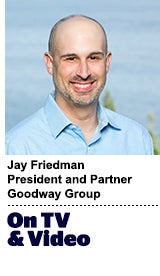“On TV And Video” is a column exploring opportunities and challenges in advanced TV.
Today’s column is written by Jay Friedman, president and partner at Goodway Group.
The goal of every marketer is to spend the least amount of money possible to achieve the best possible results – to spend right to the point where the last dollar drives profitable ROI and the next dollar won’t. Of course, there are hundreds or thousands of companies trying to get marketers to spend more, more, more.
Much of this has to do with how we’ve bought and sold advertising for decades: based on reach, frequency and panel-based data. That story is still largely true.
In the early days of digital I remember people essentially telling me, “I know I have no idea if and how well my TV is working for my brand, but you missed our CTR goal by .02% and so we’re going to cancel and put the money back into TV.”
More dollars still go to linear TV than any other single channel, and its lack of accountability is still perfectly acceptable. The game is nearly over, though. Connected TV (CTV) will change how marketers think about their total budgets, how they define their audience and how media is valued across all channels.
When I talk to marketers today, a certain reach-frequency goal within TV is still sacred. Peeling money out of TV that reduces the reach and/or frequency below the long-standing target is still a third rail. This all ends, though, once we start talking about people-based marketing.
Consumers aren’t binary – you’re either an adult who is 25 to 54 years old or you’re not. They instead represent a probability to purchase, purchase again or purchase at a greater frequency. In other words, consumers in this new targeting landscape are not represented by a 0% or 100% probability of purchasing, but rather they will exist on a spectrum of probability to purchase, and that spectrum will drive the value of the audience.
For example, if Joe Smith has a 61% chance of purchasing the product we’re advertising, then we need to pay the right price to place the right ads in the right environments and channels that will favor the 61% side of the equation and not the 39%.
As marketers start to see that they can effectively hand-pick the consumers that best represent the potential to become a customer, across all devices, including programmatic audio and CTV, and layer this spend into their plan first, they will quickly realize that linear broadcast’s best use is as the “next layer” of a plan and not the first layer.
As the value of the 91% user and the 84% user becomes clear compared to the 22% user and the 36% user, marketers will realize there should be no blanket CPM target. Instead, the price that is worth paying for each user must continuously get re-evaluated as the campaign goes on. If the value of a new customer sign-up is $150, it’s worth spending, theoretically, up to $120 of media on a user with an 80% chance of converting.
Some marketers have figured out that paying a $40 CPM for a display ad or a $120 CPM for a CTV ad can actually be smart so long as it’s the right user and they know how to measure. This doesn’t mean to pay more for all media, but if we know the right users and can target them across channels and devices, it won’t be long until high-value users are bought at appropriately valued prices.
Follow Jay Friedman (@jaymfriedman) and AdExchanger (@adexchanger) on Twitter.












